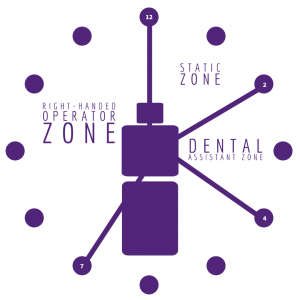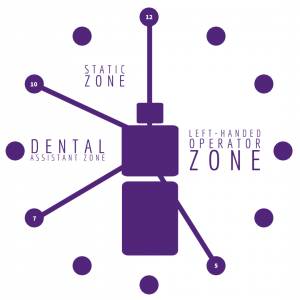Ergonomics
Operator and patient positioning
Sowmya Shetty and Veronica Kindaro
Learning Objectives
Describe ideal operator and patient positioning for optimal musculoskeletal health.
Understand the role of correct posture in dental practice.
Principles
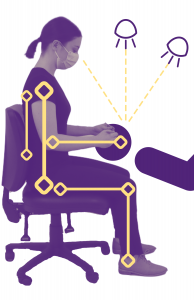
In clinical practice, the dental operator and dental assistant work closely together. It is important for members of the dental team to understand how the other member functions in the team. For maximum and safe functionality, the dental practitioner, the dental assistant and the patient must all be positioned ergonomically with minimum distortion of the back and neck. Comfort, access and health is paramount.
Operator positioning
Ideally the operator should be seated for all dental procedures.
- The back should be straight and well supported by the operator chair.
- The upper arms should be straight with elbows bent and lower arms parallel to floor.
- The head should be as straight as possible.
- There is additional strain applied to the neck muscles, for every inch that the head moves forward.
- The eyes can be tilted or inclined downwards, instead of moving the whole head forward.
- Operator thighs should be well supported by the chair and be parallel to floor.
- The knees are bent at right angles and feet should be firmly on the floor.
- The operator hands and forearms will be parallel to the floor in a lower position, for non-precision work.
- The operator hands and forearms may be in a higher position, bent at elbows to achieve a smaller working distance in case of precision work.
Dental assistant positioning
The dental assistant’s seat is about 4-6 inches higher than the operator.
- The assistant’s hips are between their shoulder and biceps when sitting straight.
- The arm rest is placed in front of the dental assistant, under their ribs.
- It is used as a reminder to not lean forward.
- Finally the metal ring on the dental assistant chair supports their feet, and prevents them from dangling in the air.
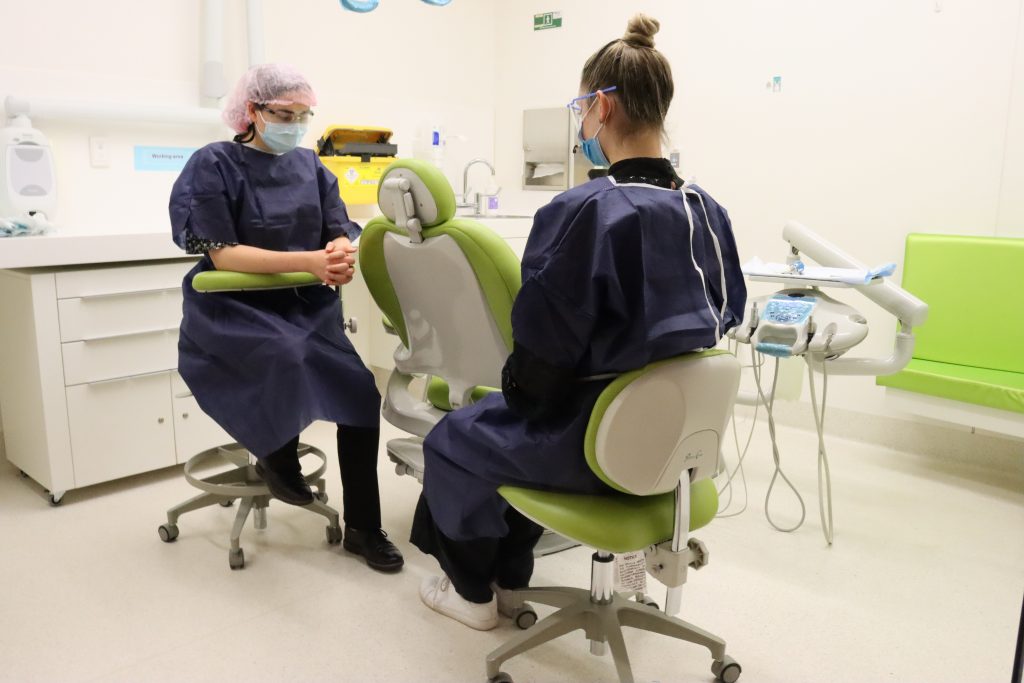
Patient positioning
It is important to consider patient positioning for minimising injuries in the operator and for patient comfort throughout the appointment.
- The patient chair will be at a higher position than the operator and assistant.
- The distance between the operator’s eyes and the patient’s tooth must be between 35 to 45 cm depending on the level of precision required.
- To ensure ergonomic positioning for the operator, allowing for maximum working area, the patient must be in a comfortable yet practical position.
- Patient positioning is dependent on the procedure type, and location of working site.
- Any existing medical conditions that the patient might have must be accommodated for.
- These conditions may include but are not limited to vertigo, pregnancy, and geriatric patients.
- These patients may not be able to or sustain a reclined position for appointment durations.
Maxillary arch
The ideal patient positioning for treatment in the maxillary arch is the supine position.
- This involves having the head, knees and feet at approximately the same level.
- Patient’s head should not be lower than the legs for their comfort.
- The patient’s maxillary occlusal surfaces should be perpendicular to the floor.
- A good way to remember how to adjust the patient’s head rest is that the patient will need to be in a “chin up” position.
Mandibular arch
When working in the mandibular arch, it is ideal to have the patient in a 45° semi-supine position.
- This ensures that the mandibular occlusal surfaces are at a 45° angle to the floor.
- The working area should be at elbow level or slightly higher when operating.
- It will avoid any arm adduction or shoulder elevation which may result in neck and shoulder pain.
- A good way to remember how to adjust the patient’s head rest is that the patient will need to be in a “chin down” position.
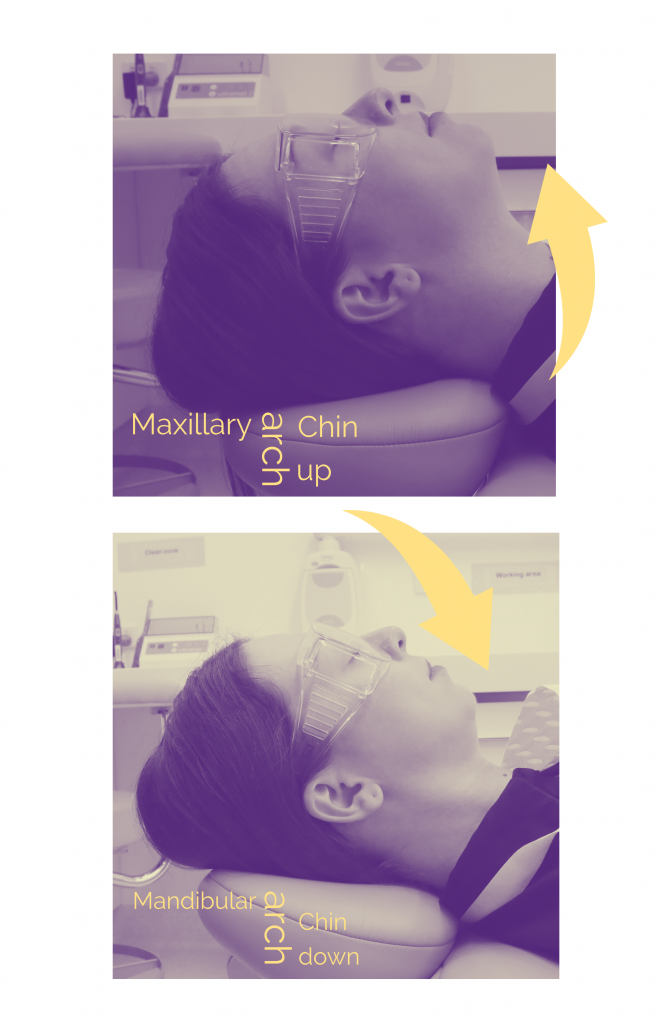
Practical application to the dental environment
Right and left dominant handed operators
Most surgeries are designed for right handed practitioners but increasingly are set up in a universal manner so both right and left handed operators can use the same chair and workstation with a few adjustments.
Depending on the operator’s dominant hand and the location of the working area, sometimes, it can be beneficial to tilt the patient’s head left or right for maximum vision and working space. However, this can only be done if the patient is comfortable to remain in such a position for the duration of the treatment.
Normal variations requiring adaptations
Geriatric patients may encounter some difficulty in positioning themselves in a dental chair. As most elderly patients have a defined forward head position, it may be beneficial to:
- Use neck pillows for patient comfort.
- Adjust the head rest of the chair for further support.
This will relax the patient’s neck muscles and ultimately provide increased visibility for the operator. If the patient is unable to be in supine position for an extended period of time, the patient should be seated at a 60° angle or even a 90° angle. The operator may need to stand when delivering treatments in such circumstances.
The height of patients is an important consideration, particularly in shorter patients. It may be beneficial to place a pillow under their knees to allow the patient to push themselves further up in the chair.
Key Takeaways
- It is important to have correct operator, patient and dental assistant positioning to minimise distortion of the neck and back.
- Positioning will differ depending on the procedure, and if it in the maxillary or mandibular arch or an anterior or posterior tooth being treated. Making sure adjustments are made accordingly will significantly reduce the risk of injury for the operator.
- Surgeries traditionally have been designed for right handed use, making it harder for left handed operators to adjust accordingly in the past. However, increasingly, surgeries are designed for universal use and minor adjustments can be made to allow for correct positioning and posture.
The dental arch formed by the teeth of the maxilla.
Lying face upwards.
At an angle of 90° to a given line, plane, or surface or to the ground.
The dental arch formed by the teeth of the mandible.
Positions where the upper body is tilted (at 45° or variations) and not completely horizontal.
The movement of a limb or other part towards the midline of the body or towards another part.

